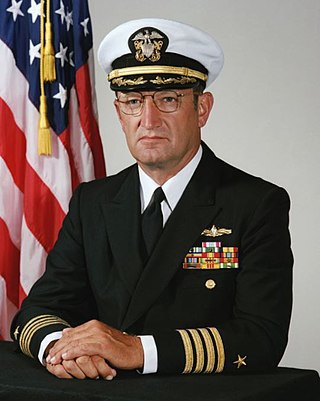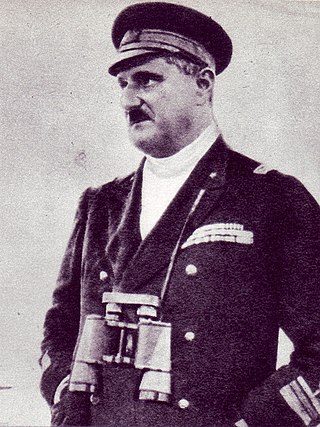
Fulvio Martini (26 February 1923 - 15 February 2003) was an Italian Navy admiral and intelligence officer. He was the head of Military Security and Intelligence between 5 May 1984 and 26 February 1991. [1] [2]

Fulvio Martini (26 February 1923 - 15 February 2003) was an Italian Navy admiral and intelligence officer. He was the head of Military Security and Intelligence between 5 May 1984 and 26 February 1991. [1] [2]
Fulvio Martini was born in Trieste which a few years earlier had been transferred from Austria-Hungary to Italy in the context of the wartime treaty commitments whereby the British and their allies had persuaded Italy to join in the war on the allied side. During the Second World War he enlisted in the Italian navy. Martini's first assignment was as a junior officer on the ageing battleship Duilio. He continued his naval career after the war ended, serving between 1972 and 1973 as ship's captain on the battle cruiser Vittorio Veneto, at which time the vessel was the flagship of the Italian navy.
His long career in military intelligence began in 1956. He served till 1962 in the naval branch of the military intelligence and status information service ("Servizio Informazioni Operative e Situazione" / SIOS A2). Stationed in the Bosphorus area to monitor movements of the Soviet merchant fleet to and from the Mediterranean, he was involved in providing the Americans with photographs of missile parts being transported to Cuba. In the hands of the Americans these images played an important part in demolishing General Secretary Kruschev's assertions of the Soviet Union's "innocence" during the Cuban Missile Crisis. After that, he headed up "Department S" (subsequently renamed as the "situation analysis department") of the Military Intelligence Service.
Between 1965 and 1968 he was based in Belgrade as naval attaché to Yugoslavia. Then, till 1977 he continued to work in the "SID" military intelligence service, living through a period of reform for the Italian intelligence services. Shortly after the launch in 1977 of the SISMI and SISDE (reconfigured intelligence services) Martini was given another naval command at sea.
The P2 scandal rose up the political agenda at the end of the 1970s. Slow but inordinate investigation indicated that top SISMI personnel, who had made their careers in its predecessor organisation, the SED had been members of the discredited lodge. Martini was an experienced intelligence officer untainted by the affair and took charge of the SISMI, purging the organisation of residual fascist elements and others involved in the P2 conspiracies. His scope for manoeuvre was limited by the need to sustain existing structures in response to the country's Cold War obligations, but he nevertheless succeeded in transforming the SISMI into an efficient and modern intelligence service, and lifting from it the shadow of a "secret police" guiding spirit.

The Cuban Missile Crisis, also known as the October Crisis in Cuba, or the Caribbean Crisis, was a 13-day confrontation between the governments of the United States and the Soviet Union, when American deployments of nuclear missiles in Italy and Turkey were matched by Soviet deployments of nuclear missiles in Cuba. The crisis lasted from 16 to 28 October 1962. The confrontation is widely considered the closest the Cold War came to escalating into full-scale nuclear war.
The Hunt for Red October is the debut novel by American author Tom Clancy, first published on October 1, 1984, by the Naval Institute Press. It depicts Soviet submarine captain Marko Ramius as he seemingly goes rogue with his country's cutting-edge ballistic missile submarine Red October, and marks the first appearance of Clancy's most popular fictional character, Jack Ryan, an analyst working for the Central Intelligence Agency, as he must prove his theory that Ramius is intending to defect to the United States.

Propaganda Due was a Masonic lodge, founded in 1877, within the tradition of Continental Freemasonry and under the authority of Grand Orient of Italy. Its Masonic charter was withdrawn in 1976, and it was transformed by Worshipful Master Licio Gelli into an international, illegal, clandestine, anti-communist, anti-Soviet, anti-Marxist, and radical right criminal organization and secret society operating in contravention of Article 18 of the Constitution of Italy that banned all such secret associations. Licio Gelli continued to operate the unaffiliated lodge from 1976 to 1984. P2 was implicated in numerous Italian crimes and mysteries, including the collapse of the Holy See-affiliated Banco Ambrosiano, the contract killings of journalist Carmine Pecorelli and mobbed up bank president Roberto Calvi, and political corruption cases within the nationwide Tangentopoli bribery scandal. P2 came to light through the investigations into the collapse of Michele Sindona's financial empire.

The Cuban Revolutionary Armed Forces are the military forces of Cuba. They include Revolutionary Army, Revolutionary Navy, Revolutionary Air and Air Defense Force, and other paramilitary bodies including the Territorial Troops Militia, Youth Labor Army, and the Defense and Production Brigades, plus the Civil Defense Organization and the National Reserves Institution. All these groups are subordinated to the Ministry of the Revolutionary Armed Forces.
Operation Anadyr was the code name used by the Soviet Union for its Cold War secret operation in 1962 of deploying ballistic missiles, medium-range bombers, and a division of mechanized infantry to Cuba to create an army group that would be able to prevent an invasion of the island by United States forces. The plan was to deploy approximately 60,000 personnel in support of the main missile force, which consisted of three R-12 missile regiments and two R-14 missile regiments. However, part of it was foiled when the United States discovered the plan, prompting the Cuban Missile Crisis.

Oleg Vladimirovich Penkovsky, codenamed Hero and Yoga was a Soviet military intelligence (GRU) colonel during the late 1950s and early 1960s. Penkovsky informed the United States and the United Kingdom about Soviet military secrets, including the appearance and footprint of Soviet intermediate-range ballistic missile installations and the weakness of the Soviet intercontinental ballistic missile program. This information was decisive in allowing the US to recognize that the Soviets were placing missiles in Cuba before most of them were operational. It also gave US President John F. Kennedy, during the Cuban Missile Crisis that followed, valuable information about Soviet weakness that allowed him to face down Soviet leader Nikita Khrushchev and resolve the crisis without a nuclear war.
Servizio per le Informazioni e la Sicurezza Militare was the military intelligence agency of Italy from 1977–2007.
Dieter Felix Gerhardt is a former commodore in the South African Navy and commander of the strategic Simon's Town naval dockyard. He was arrested by the FBI in New York City in 1983 following information obtained from a Soviet defector. He was convicted of high treason as a spy for the Soviets for a period of twenty years in South Africa together with his second wife, Ruth, who had acted as his courier. Both were released prior to the change of government following the 1994 general election.

Peter Anthony Huchthausen was a Captain in the United States Navy and the author of several maritime books.

Comitato Esecutivo per i Servizi di Informazione e Sicurezza was an Italian government committee whose mission was the coordination of all the intelligence sector, and specifically between the two civilian and military intelligence agencies, with the aim to report all the relevant information collected by it to the political Authorities, represented by the Presidency of the Council of Ministers.
Rocco Martino is an Italian secret agent. He was born in Tropea, province of Catanzaro.

The Abu Omar Case was the abduction and transfer to Egypt of the Imam of Milan Hassan Mustafa Osama Nasr, also known as Abu Omar. The case was picked by the international media as one of the better-documented cases of extraordinary rendition carried out in a joint operation by the United States' Central Intelligence Agency (CIA) and the Italian Military Intelligence and Security Service (SISMI) in the context of the global war on terrorism declared by the George W. Bush administration.

Dino Antonio Brugioni was a former senior official at the CIA's National Photographic Interpretation Center (NPIC). He was an imagery analyst and also served as NPIC's Chief of Information. During his 35-year career, Brugioni helped establish imagery intelligence (IMINT) as a national asset to solve intelligence problems. Even after retirement, Brugioni was considered to be the world's foremost imagery intelligence analyst.
Italian intelligence agencies are the intelligence agencies of Italy. Currently, the Italian intelligence agencies are the Agenzia Informazioni e Sicurezza Esterna (AISE), focusing on foreign intelligence, and the Agenzia Informazioni e Sicurezza Interna (AISI), focusing on internal security. They form part of the Department of Information for Security, which in turn is part of the Presidency of the Council of Ministers. The agencies have been reorganized multiple times since the birth of the Italian Republic in 1946 to attempt to increase effectiveness.
The Italian Military Information Service was the military intelligence organization for the Royal Army of the Kingdom of Italy from 1925 until 1946, and of the Italian Republic until 1949. The SIM was Fascist dictator Benito Mussolini's equivalent to the German Abwehr. In the early years of the war, the SIM scored important intelligence successes. Rommel’s successful military operations in North Africa in 1942 were substantially facilitated by the SIM through the securing of the U.S. Black Code used by Colonel Bonner Fellers to communicate plans for British military operations to his Headquarters in Washington.
The United States government collaborated with the Italian Mafia during World War II and afterwards on several occasions.
The Government of the United Kingdom maintains several intelligence agencies that deal with secret intelligence. These agencies are responsible for collecting, analysing and exploiting foreign and domestic intelligence, providing military intelligence, and performing espionage and counter-espionage. Their intelligence assessments contribute to the conduct of the foreign relations of the United Kingdom, maintaining the national security of the United Kingdom, military planning, public safety, and law enforcement in the United Kingdom. The four main agencies are the Secret Intelligence Service, the Security Service (MI5), the Government Communications Headquarters (GCHQ) and Defence Intelligence (DI). The agencies are organised under three government departments, the Foreign Office, the Home Office and the Ministry of Defence.

The Cuban Revolutionary Navy is the navy of Cuba.
The Servizio Informazioni Segrete was the intelligence service of the Royal Italian Navy. SIS was instrumental in moulding Italian Army's operations during the Second Italo-Ethiopian War and the Battle of the Mediterranean, primarily due to its cryptanalysis successes and undercover operations.

Alberto Lais was an Italian admiral during World War II, naval attaché in Washington and member of the Servizio Informazioni Segrete.